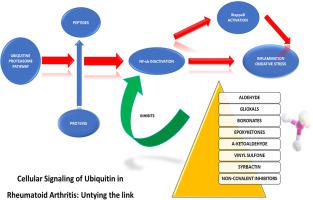Life Sciences ( IF 5.2 ) Pub Date : 2020-09-19 , DOI: 10.1016/j.lfs.2020.118459 Tapan Behl 1 , Swati Chadha 1 , Monika Sachdeva 2 , Arun Kumar 1 , Abdul Hafeez 3 , Vineet Mehta 4 , Simona Bungau 5

|
Rheumatoid arthritis is a chronic, inflammatory joint disease leading to inflammation of synovial membrane that lines the joints. This inflammation further progresses and results in destruction of joints and surrounding cartilages. The underlying factors can be oxidative stress, pro-inflammatory mediators, imbalance and attenuation between various enzymes and proteins (like nuclear factor erythroid 2 related factor 2/Nrf2 and ubiquitin). Protein degradation pathways comprises of lysosomal, proteasomal pathway, and autophagosome (that are carried out in mammalian cells) are regulated through ubiquitin. Ubiquitin proteasomal system is dominating pathway for carrying out non-lysosomal proteolysis of intracellularly proteins. Fundamental processes including cell cycle progression, process of division, apoptosis, modulation of immune responses and cell trafficking are regulated by process of ubiquitination. Ubiquitin proteasomal pathway (UPP) includes ubiquitin moieties which are covalently attached to proteins and guides them proteasome for degradation. Misfolded, oxidized and damaged proteins which are responsible for critical processes, are major targets of degradation process. Any alteration in this system leads to dysregulated cellular homeostasis; progressively leading to numerous diseases including rheumatoid arthritis. Factors including TAK1, TRAF6 undergo are required for the progression of disease and thus contributes towards pathology of inflammatory disorders such as rheumatoid arthritis. This review will include all linked aspects which contribute its major role in rheumatoid arthritis.
中文翻译:

类风湿关节炎的泛素化。
类风湿关节炎是一种慢性炎性关节疾病,会导致关节内滑膜发炎。这种炎症进一步发展并导致关节和周围软骨的破坏。潜在的因素可能是氧化应激,促炎介质,各种酶和蛋白质之间的失衡和减弱(例如核因子类红细胞2相关因子2 / Nrf2和泛素)。蛋白质降解途径包括溶酶体途径,蛋白酶体途径和自噬体(在哺乳动物细胞中进行)是通过泛素调节的。泛素蛋白酶体系统是进行细胞内蛋白的非溶酶体蛋白水解的主要途径。基本过程包括细胞周期进程,分裂过程,凋亡,免疫反应的调节和细胞运输受泛素化过程调节。泛素蛋白酶体途径(UPP)包括与蛋白质共价连接并指导其蛋白酶体降解的泛素部分。导致关键过程的错误折叠,氧化和损坏的蛋白质是降解过程的主要目标。该系统的任何改变都会导致细胞动态平衡失调。逐渐导致多种疾病,包括类风湿关节炎。疾病的发展需要包括TAK1,TRAF6在内的因素,因此有助于类风湿关节炎等炎症性疾病的病理。这篇综述将包括在风湿性关节炎中起主要作用的所有相关方面。泛素蛋白酶体途径(UPP)包括与蛋白质共价连接并指导其蛋白酶体降解的泛素部分。导致关键过程的错误折叠,氧化和损坏的蛋白质是降解过程的主要目标。该系统的任何改变都会导致细胞动态平衡失调。逐渐导致多种疾病,包括类风湿关节炎。疾病的发展需要包括TAK1,TRAF6在内的因素,因此有助于类风湿关节炎等炎症性疾病的病理。这篇综述将包括在风湿性关节炎中起主要作用的所有相关方面。泛素蛋白酶体途径(UPP)包括与蛋白质共价连接并指导其蛋白酶体降解的泛素部分。导致关键过程的错误折叠,氧化和损坏的蛋白质是降解过程的主要目标。该系统的任何改变都会导致细胞动态平衡失调。逐渐导致多种疾病,包括类风湿关节炎。疾病的发展需要包括TAK1,TRAF6在内的因素,因此有助于类风湿关节炎等炎症性疾病的病理。这篇综述将包括在风湿性关节炎中起主要作用的所有相关方面。导致关键过程的错误折叠,氧化和损坏的蛋白质是降解过程的主要目标。该系统的任何改变都会导致细胞动态平衡失调。逐渐导致多种疾病,包括类风湿关节炎。疾病的发展需要包括TAK1,TRAF6在内的因素,因此有助于类风湿关节炎等炎症性疾病的病理。这篇综述将包括在风湿性关节炎中起主要作用的所有相关方面。导致关键过程的错误折叠,氧化和损坏的蛋白质是降解过程的主要目标。该系统的任何改变都会导致细胞动态平衡失调。逐渐导致多种疾病,包括类风湿关节炎。疾病的发展需要包括TAK1,TRAF6在内的因素,因此有助于类风湿关节炎等炎症性疾病的病理。这篇综述将包括在风湿性关节炎中起主要作用的所有相关方面。TRAF6经历疾病的发展是必需的,因此有助于炎症性疾病(如类风湿关节炎)的病理。这篇综述将包括在风湿性关节炎中起主要作用的所有相关方面。TRAF6经历疾病的发展是必需的,因此有助于炎症性疾病(如类风湿关节炎)的病理。这篇综述将包括在风湿性关节炎中起主要作用的所有相关方面。









































 京公网安备 11010802027423号
京公网安备 11010802027423号